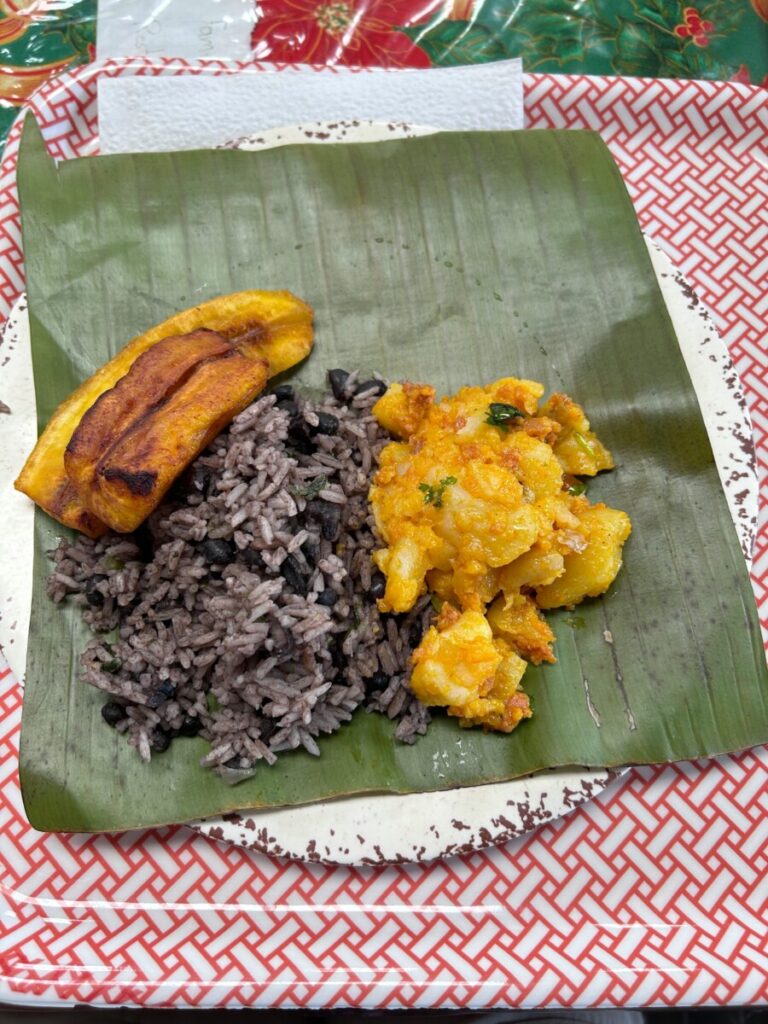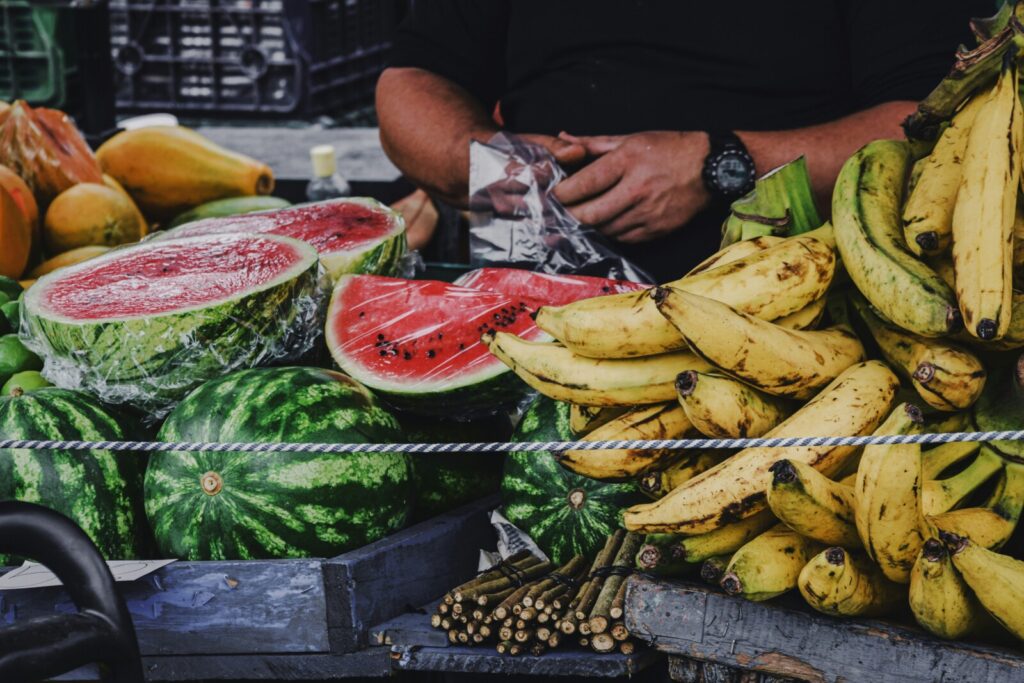Costa Rica, a Central American country known for its remarkable biodiversity, political stability, and focus on sustainability, has become a popular destination for international volunteer experiences.
Bordered by Nicaragua to the north and Panama to the southeast, and surrounded by the Pacific Ocean, Costa Rica enjoys a rich variety of cultural and culinary influences.
If you choose it as your next travel destination, you won’t regret it. As we often say, a country can also be discovered through its cuisine. Today, we want to introduce you to some of the most typical dishes you can find in Costa Rica.
The country’s gastronomy is an essential part of creating an unforgettable experience.

- GALLO PINTO
This dish is considered the traditional breakfast of Costa Rica and one of the country’s most representative dishes. It is a mix of rice and black or red beans, seasoned with spices such as onion, sweet pepper, cilantro, and of course, Salsa Lizano, a typical condiment that gives it its distinctive flavor.
Gallo Pinto has roots in Afro-Caribbean and Indigenous cuisine and is an iconic dish not only in Costa Rica but also in Nicaragua. Although both countries have their version, Costa Rican Gallo Pinto is distinguished by the use of Salsa Lizano and the way the rice is cooked with the beans.
It is often served with eggs (fried or scrambled), sour cream (natilla), fried ripe plantains, and tortillas. It is also common to add fresh cheese or avocado. Some people enjoy it with meat or even bread.
The ingredients for the basic recipe include: cooked white rice, black beans cooked in their broth, chopped onion, chopped sweet pepper, a sprig of cilantro, Salsa Lizano, vegetable oil, and salt and pepper to taste.
In a large skillet, heat the oil and sauté the onion and sweet pepper until soft. Add the beans with a little of their broth and mix well. Add the cooked rice and stir until everything is well combined. Finally, add the Salsa Lizano, cilantro, salt, and pepper to taste, and cook for a few minutes until the rice takes on color and flavor. Then, simply serve with your preferred sides.
Gallo Pinto is not just a breakfast but also an essential part of Costa Rican identity.
- SOPA NEGRA
Sopa Negra is a traditional recipe made with black beans, cilantro, and spices. It is a comforting, light, and nutritious dish, ideal for dinner or cold days.
This dish has roots in Costa Rican rural cuisine and is appreciated for its simplicity and nutritional value. It is very common in homes throughout the country, especially in the central region.
It is often served with a hard-boiled egg in the soup and enjoyed with corn tortillas or bread. It is also common to add a few drops of Salsa Lizano (the country’s star sauce) to enhance the flavor.
The main ingredients are: black beans in their broth, water, chopped onion, garlic cloves, chopped sweet pepper, a sprig of cilantro, vegetable oil, cumin, salt, and pepper to taste, and eggs.
In a pot, heat the oil and sauté the onion, sweet pepper, and garlic until golden. Add the beans with their broth and the water and let it boil for about 10 minutes. Add the chopped cilantro, cumin, salt, and pepper and cook for another 10 minutes. To give it more body, blend part of the soup. Add the whole eggs until they cook in the soup and become hard-boiled. Finally, serve hot with corn tortillas or bread.
A simple dish but present in many homes.
- CHIFRIJO
Considered the country’s favorite snack, Chifrijo is one of the most popular dishes, especially in bars or cantinas. It is a combination of crispy pork cracklings, beans, and rice, served with pico de gallo and avocado.
Its name comes from the fusion of its two main ingredients: “chi” from chicharrón (pork cracklings) and “frijo” from frijoles (beans). Beans are very present in Costa Rican dishes.
This dish was born in San José in the 1990s and quickly became a classic of Costa Rican cuisine. It is considered more of a “boca” (snack) than a main dish and is ideal for sharing with friends, accompanied by a beer or natural juice.
The main ingredients are: cooked white rice, cooked red or black beans, crispy pork cracklings, sliced avocado, pico de gallo (tomato, onion, cilantro, lime, salt, and pepper), and tortilla chips or corn tostadas, which are also common in recipes.
The pico de gallo is prepared by mixing all the ingredients, and in a bowl or deep plate, a base of rice is placed, followed by the beans, the pork cracklings, and topped with the pico de gallo and avocado. A very simple preparation.
Chifrijo is a simple dish but explosive in flavor. Its combination of textures and mix of ingredients makes it irresistible.

- CASADO
This dish, considered one of the most iconic in Costa Rica, is served as lunch in almost every home and “soda” (small local restaurants). It is a complete meal that combines rice, beans, meat, salad, fried ripe plantains, and picadillo, creating a perfect balance between flavor and nutrition.
The name “Casado” is said to come from the lunches served to married men in restaurants, similar to what their wives would prepare for them at home. It is also believed to refer to the combination of various “married” ingredients in one plate.
Casado is a hearty dish that can include different types of meat: chicken, beef, pork, or fish, accompanied by rice, beans, salad, plantains, and, in some cases, picadillo or tortillas.
The rice and beans are cooked separately, and the meat is grilled, roasted, or stewed with spices to taste. The ripe plantains are fried in oil until golden. The salad is simple, seasoned with lime, oil, and salt. The picadillo is then cooked with potato, chayote, or green plantain, seasoned with garlic, onion, and cilantro. Everything is combined on a large plate, and tortillas can be added if desired.
This dish allows for many variations based on personal taste.
- CEVICHE TICO
This popular recipe from Costa Rica is especially common in coastal areas. It is a refreshing dish made from white fish marinated in lime juice, mixed with onion, sweet pepper, and cilantro. It is a light dish, perfect for hot days, and is commonly served as a starter or snack.
Unlike other Latin American ceviches, Ceviche Tico is known for its simplicity and balanced flavor. It is not typically spicy like Peruvian ceviche, and it is often served with crackers instead of corn or sweet potato.
The fish usually used is grouper, tilapia, or snapper, which is cut into small cubes and seasoned with an abundance of fresh lime juice. To marinate the fish, the cubes are placed in a bowl and covered completely with lime juice, letting it sit for half an hour to an hour to absorb all the flavor. Afterward, all the ingredients (onion, sweet pepper, cilantro, salt, pepper, and olive oil) are mixed in, and it is left to rest in the fridge for a few more minutes.
It is a healthy and flavorful option, perfect to enjoy at the beach or at any gathering.
- OLLA DE CARNE
This traditional stew is, of course, another iconic dish of the country. It is a hearty and substantial broth made with beef and a variety of vegetables such as yuca, potatoes, green plantain, chayote, and carrots. It is a very popular homemade meal, especially on weekends when families gather to enjoy it.
More than just a stew, Olla de Carne is a symbol of traditional Costa Rican cuisine. Its combination of local ingredients and slow cooking gives it a deep, comforting flavor.
The ingredients used are: beef ribs, chambarete (shank), or posta (round cut), water, corn on the cob broken into pieces, large chopped potatoes, yuca cut into pieces, green plantain, chayote, carrot, cabbage, cilantro, chopped onion, garlic cloves, oregano, salt, and pepper to taste.
In a large pot, place the meat and water, add the onion, garlic, oregano, salt, and pepper, cooking the ingredients over medium heat for 1.5 to 2 hours until the meat is tender. Then, add part of the vegetables and cook for another 20 minutes, adding the remaining vegetables for an additional 20 minutes. Let it rest with the cilantro and serve with white rice or corn tortillas.

There are other typical dishes like the Costa Rican tamal, which is different from the Mexican tamal, Rondon (very popular in the province of Limón), or arroz con pollo (rice with chicken), among others.
And of course, there are traditional desserts to end any meal, like pan bon or pan de yuca.
The cuisine is simple but full of flavor, and above all, meaningful. The unity of family is reflected in many dishes.
WILL YOU DARE TO TRY THEM?



